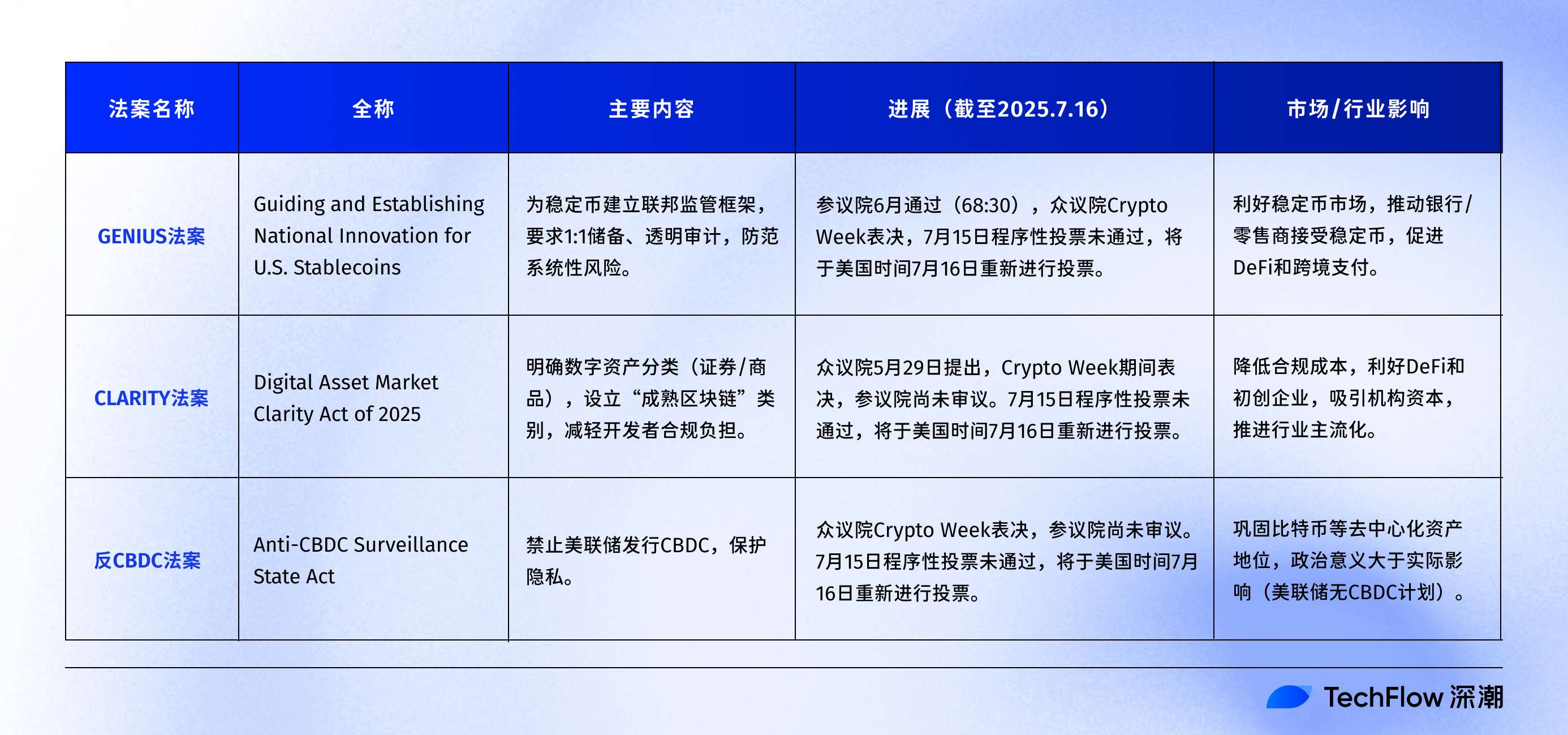Crypto Week sets the tone for the future: What new opportunities will the three major bills ignite?
Original author: TechFlow
In July, the crypto market saw another wave of activity.
BTC has broken all-time highs, and ETH spot ETF has maintained net inflows for 9 consecutive weeks; and last week, ETH spot net inflows reached 850 million US dollars, setting a record. The pace of funds has never stopped, and the market feels like it is getting better again.
However, the real catalyst may not be in the price curve, but in the U.S. House of Representatives in Washington, DC.
From July 14 to 18, the House of Representatives announced "Crypto Week" and for the first time focused on reviewing three landmark bills: the GENIUS Act, the CLARITY Act, and the Anti-CBDC Act, targeting stablecoins, digital asset classification, and central bank digital currency (CBDC), respectively.
This intensive legislative feast is not only a turning point for the U.S. crypto industry, but is also likely to affect the direction of the entire crypto market and asset changes.
Let’s take a look at the progress of the three major bills this week and catch the market pulse of Crypto Week.
Panorama of bills: the core and progress of three pieces of legislation
As of July 16, Crypto Week is in full swing.
The three bills that the House of Representatives is focusing on reviewing cover the core tracks of the crypto market, ranging from stablecoin payments to decentralized finance (DeFi) to Bitcoin's decentralized narrative.
The three pieces of legislation focus on different aspects, but all of them point to a common theme - "compliance".
The GENIUS Act: A legal foundation for stablecoins
The full name of the GENIUS Act is "Guiding and Establishing National Innovation for US Stablecoins". It aims to establish a federal regulatory framework for stablecoins, clarify the qualifications of stablecoin issuers, 1:1 US dollar or US Treasury reserve requirements, and transparent audit mechanisms. Through regulations such as the 1:1 reserve requirement, stablecoins can be truly "stable" to avoid the recurrence of events similar to the Terra crash in 2022.
In terms of legislative progress, the Senate passed the bill in June 2025 with a vote of 68:30. During Crypto Week this week, the House of Representatives originally planned to vote on the bill on Thursday (July 17, US time). Today, July 15, US time, the House Rules Committee passed the discussion rules, but the procedural vote (determining whether the bill enters the formal debate) failed with a vote of 196:223. 12 Republican hardliners opposed the bill, and the organization bill entered the debate.
On the evening of July 15th, US time, Trump posted on the Truth Social platform that he would meet with 11 opposing Republican lawmakers, saying that they had agreed to vote again in favor of the rule provisions on the morning of July 16th (US time). U.S. House Speaker Johnson said he hoped to try again in the House of Representatives on Wednesday for a procedural vote on the cryptocurrency bill.
Although it has experienced some unexpected twists and turns, the probability of the GENIUS Act being passed is still very high. If the vote is successfully passed, it means that the GENIUS Act will likely become the fastest bill to be implemented during Crypto Week, paving the way for stablecoins to be integrated into mainstream finance.
CLARITY Act: The innovation engine for exchanges and DeFi
The full name of the CLARITY Act is “Digital Asset Market Clarity Act of 2025”. It focuses on the definition and regulatory attribution of digital assets. If passed, it will end the long-term chaotic situation of digital assets being regulated by the SEC (Securities and Exchange Commission) and CFTC (Commodity Futures Trading Commission).
The bill clarifies which crypto assets are securities (regulated by the SEC) or commodities (regulated by the CFTC) and creates a “mature blockchain” category for decentralized networks, exempting some developers from compliance obligations as money transmitters.
In terms of legislative progress, this bill was proposed by the House Financial Services Committee and the Agriculture Committee on May 29, 2025, and was originally scheduled to be voted on today. However, due to the failure of the procedural vote on July 15 (US time), it was blocked along with the GENIUS Act and has not yet entered formal debate.
Trump has said that he has persuaded opposing lawmakers to support the bill, and a vote may be held on the afternoon of July 16 (US time), with a high probability of passage. If it is successfully passed, it will reduce compliance costs for exchanges such as Coinbase and DeFi protocols such as Uniswap, unleashing innovation potential.
Anti-CBDC Bill: Leave decentralization to the market, not the government
The full name of the anti-CBDC bill is the “Anti-CBDC Surveillance State Act”, which mainly prohibits the Federal Reserve from issuing central bank digital currencies (CBDCs) on the grounds that CBDCs may lead to excessive government monitoring of personal finances. The bill caters to the privacy concerns of users in the crypto market, strengthens the status of decentralized assets such as BTC, and also removes the “competitive” obstacles for the subsequent development of crypto assets.
In terms of legislative progress, although the voting process of the anti-CBDC bill has not yet been clarified, the U.S. House of Representatives Financial Services Committee has made it clear that the anti-CBDC bill will be put on the agenda for review during Crypto Week this week. If the U.S. government releases relevant information in the future, it will greatly enhance the confidence of the crypto market and may indirectly promote the development of privacy coins and anonymous technologies.
Legislative prospects and market expectations
The U.S. legislative process requires that the bill be passed by the House of Representatives (218 votes out of a total of 435) and the Senate (51 votes out of a total of 100), and then sent to the President for signature after the versions are consistent.
This week’s Crypto Week is the voting window for the House of Representatives. Overall, the GENIUS Act is closest to becoming law, while the CLARITY and anti-CBDC bills will take longer.
We can also use a table to quickly sort out the progress and details of the three bills:

How three pieces of legislation are reshaping the crypto landscape
It is clear that the final voting results of Crypto Week will directly affect market sentiment.
The more far-reaching impact is that this is not only about providing a compliance framework, but also about pushing the industry from "wild growth" to maturity and mainstreaming. Let's take a closer look at the impact of legislation on different crypto tracks in more detail.
Stablecoins: Step by step to the center of the stage
Stablecoins are undoubtedly one of the "mainstream narratives" in the global financial and economic markets this year. From the 900% increase in the share price of Circle, the issuer of stablecoin USDC, in the three weeks since its listing, to JD.com and Ant launching Hong Kong dollar stablecoin plans, to today's announcement by Citi's CEO that Citi is exploring the possibility of issuing stablecoins, every step seems to indicate that stablecoins, a track that was once spurned by everyone due to the Terra crash, are moving step by step to the center of the stage.
The GENIUS Act clarifies the regulatory framework for stablecoins, giving them legitimacy and stability. The $2.38 trillion stablecoin market has become the core of global payments and DeFi. The chain reaction brought about by this move has begun to emerge. Banks and retail giants (Walmart, Amazon, etc.) integrate stablecoin payments to accelerate their application in cross-border remittances and payments. In addition, DeFi protocols (Aave, Curve) that rely on stablecoins to provide liquidity will also be affected and push up TVL.
Exchanges and DeFi: Catalysts for Innovation and Institutional Funding
The CLARITY Act clarifies the regulatory ownership of digital assets, clears compliance barriers for exchanges and DeFi, and unleashes huge potential. Centralized exchanges such as Coinbase and decentralized exchanges such as Uniswap have been repeatedly punished by the SEC and CFTC due to unclear regulation. After the passage of the bill, the reduction in compliance costs will drive a surge in trading volume and attract more retail and institutional users to enter the market.
Among them, opportunities in the Defi field will be particularly significant: relaxed regulations may encourage developers to launch new protocols, and Web3, NFT and decentralized identity (DID) will usher in significant explosive growth.
The hidden opportunities include institutional capital inflows and a start-up boom: financial institutions are likely to accelerate the promotion of more cryptocurrency ETFs, while developer protection clauses will spur a blockchain start-up boom and attract venture capital. Compared with the strict regulation of the European Union, the loose policy of the United States will provide investors with a lot of cross-border arbitrage space.
Decentralized assets: Building a moat for privacy
The anti-CBDC bill defends the concept of decentralization, will consolidate BTC's position as "digital gold", and open up a new track for privacy technology. Bitcoin's earnings, institutional investment and community belief, the bill further strengthens its anti-censorship narrative and attracts long-term holders. Privacy coins (Monero, Zcash, etc.) and anonymous technologies will also rise due to the increased demand for privacy protection.
Different from the CBDC process of other countries, the proponents of the anti-CBDC bill believe that the government's introduction of CBDC will become a "monitor" of user assets, which is in direct conflict with the decentralized core concept of Web3. The United States's leading anti-CBDC action will undoubtedly make people and money in the crypto field more inclined to choose the United States as their "base". If the United States becomes a "safe haven" for decentralized assets, it will further consolidate its attractiveness in the global crypto market.
Crypto Week sets the tone for the industry’s future
Since "Crypto President" Trump came to power, the US government's attitude towards the cryptocurrency field has undergone a huge change.
Behind this, there are also quite a number of Wall Street institutions and U.S.-listed companies that have sensed the change in the U.S. government's attitude towards cryptocurrencies, and the government's promotion of industry compliance has undoubtedly broken the last concerns of these giants. The amount of funds that a "rule-free" market can carry is limited, and a market with "rules" can accommodate a huge influx of funds, which will undoubtedly bring a huge amount of funds into mainstream cryptocurrencies such as BTC, ETH, and more encryption tracks.
Structural opportunities for investors amid legislative trend
Under such a trend of change, what opportunities might there be from the perspective of crypto market investors?
Please note that all the following texts are the author's personal thoughts and experiences, and do not represent any investment advice. The crypto market is changing rapidly, and although legislation has brought benefits, you still need to do your own research.
GENIUS Act (Stablecoin)
The most critical aspect of the GENIUS Act is to inject compliance momentum into the stablecoin market and promote its application in payments and DeFi. The market size is expected to grow rapidly.
The bill's more relaxed regulatory environment compared to the EU MiCA is likely to further attract global stablecoin issuers to register in the United States, creating regulatory arbitrage opportunities.
It's not just Cricle and Tether. When more companies can issue their own stablecoins and operate in compliance in the future, these companies will benefit from the positive crypto narrative and their stocks may also perform well.
At the same time, as the front end of stablecoin usage and carrying, the opportunities that wallets can obtain will be far greater than before. By integrating KYC/AML functions, compliant wallets will attract more institutional users and retail investors to enter the market.
In terms of specific assets, crypto assets such as USDC, USDT (expanding market share), DeFi protocols such as Aave, Compound (lending), Curve (stablecoin exchange); US stocks such as Circle (CRCL), Coinbase (COIN, large stablecoin trading volume), PayPal (PYPL, exploring stablecoin payments), Visa/Mastercard (V/MA, payment integration), etc. are all worthy of further attention.
(Read reference: Stablecoin bill GENIUS Act voted through, which crypto assets will benefit from it? )
The CLARITY Act: Exchanges and the Growth Potential of DeFi
The LARITY Act reduces compliance costs for exchanges and DeFi projects by clarifying asset classification and developer protection, driving trading volume and innovation. Centralized and decentralized exchanges will benefit from user growth.
Favorable assets include: crypto assets such as ETH (DeFi core), SOL (high-performance blockchain), UNI (Uniswap); US stocks such as Coinbase (COIN), Robinhood (HOOD, supports crypto transactions), Grayscale (GBTC, Bitcoin/Ethereum Trust); DeFi protocols such as Uniswap, SushiSwap, and Chainlink (cross-chain).
Anti-CBDC Bills: The Long-Term Value of Decentralized Assets
The anti-CBDC bill prohibits the Federal Reserve from issuing CBDC, strengthens the appeal of Bitcoin as a decentralized value storage, and attracts long-term holders and institutional funds. At the same time, the bill emphasizes privacy protection, which will also create narrative space for the development of privacy coins (such as Monero, Zcash) and anonymous transaction technology to a certain extent.
Favorable assets include: crypto assets such as BTC, ETH, XMR, and ZEC; US stocks such as MicroStrategy (MSTR), Bitwise (BITW, crypto asset management), and more companies with ETH asset reserves; DeFi protocols such as Tornado Cash (anonymous transactions), etc.
(Reading reference : ETH reserve companies become the new favorite of US stocks, taking stock of the business and behind-the-scenes drivers of 4 star companies )
Overall, the three major bills are driving three trends, namely the accelerated inflow of institutional funds, the integration of encryption and traditional finance, and the rise of Web3 startups.
If you must have an investment strategy and steps, then in the short term, focus on stablecoin-related assets and companies, in the medium term, deploy DeFi blue chips, in the long term, have BTC, pay attention to privacy coins and Web3 start-up projects that meet the version requirements under the new regulatory environment, which would be a good choice.



